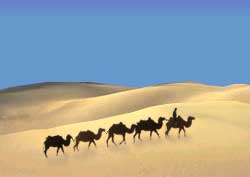Silk Road
 Why
the Silk Road
is special
Why
the Silk Road
is specialAlthough the ancient Silk Road no longer functions, retracing parts of its route offers travelers a historical and cultural adventure. The Silk Road passes through many landscapes, including deserts, grasslands and mountains.
Silk Road tips and insights
History in brief
The Silk Road was functioning across Eurasia as early as the 2nd century BC. By the time Marco Polo arrived in China in the 13th century, the Silk Road had seen its grander days. And, it would be disappearing three centuries later when the newly established sea cargo routes were safer, faster and cheaper than caravan shipping.
Trader relay
No one actually traveled the length of the Silk Road. Instead, traders specialized in working short segments of the route near their home bases. Over the course of a product's journey between East and West, it could change hands dozens of times. Think of a long chain, with the traders being the links.
Goods
China exchanged goods like silk and furs for valuables like gold and jade.
Silk Road name
The term "Silk Road" never existed until 1877 when a German geographer coined it. And, technically, Silk Road should be plural, not singular. There are several routes.
Kashgar
Many cities from Beijing to Kashgar qualify as Silk Road cities. However, the one with the most Silk Road character is Kashgar (Kashi) near China's far western border in the Xinjiang autonomous region. If you visit only one Silk Road city, let it be Kashgar.
Other popular attractions
The ancient cities of Jiaohe and Gaochang are situated near the oasis city of Turpan. The Bizaklik Buddhist caves are also nearby.
Grasslands dotted with nomadic yurt tents can be found in the Urumqi city area. Another highlight is the Silk Road corridor that includes, from east to west, Xi'an, Lanzhou, Jiayuguan, Dunhuang, and Kuqa.


